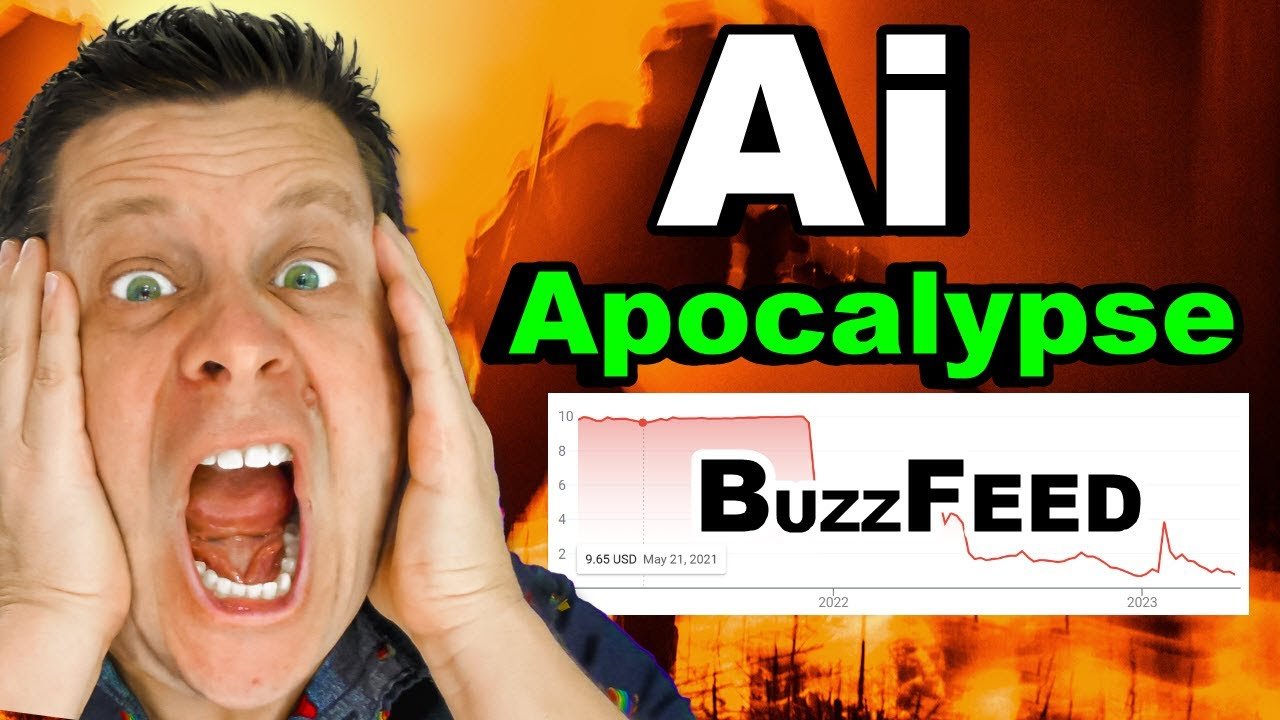Video By Buzzfeed Shutting Down: AI Content Apocalypse?” explores the recent closure of a once-thriving content giant, BuzzFeed, soon after it fully embraced AI for content creation. This piece examines whether this turn of events was a mere coincidence or a foreshadowing of a significant disruption in the digital content landscape.
With BuzzFeed’s financial decline and the rapid deployment of AI-generated content, you will gain insights into how the convergence of these factors might be influencing the broader digital realm. The discussion will also delve into the implications for online businesses, drawing parallels with other entities like WikiHow to highlight optimal strategies and pitfalls to avoid in an era increasingly dominated by AI.

This image is property of i.ytimg.com.
Background and Context
Buzzfeed’s Initial Success
Buzzfeed emerged as a digital media sensation in the mid-2000s by tapping into the burgeoning realm of internet virality. With unique content that ranged from listicles and quizzes to serious news articles, Buzzfeed managed to capture a wide audience. The platform became a powerhouse in online media, attracting millions of monthly visitors and creating a brand synonymous with trendy, easily consumable content. Buzzfeed’s innovative approach to content distribution, coupled with its keen sense for online trends, catapulted the company to a peak valuation of $437 million annually.
Transition to AI Content
In search of further growth and efficiency, Buzzfeed began exploring the potential of artificial intelligence (AI) to automate content creation. By leveraging AI tools like GPT-3, the company hoped to generate vast quantities of content at a lower cost and quicker pace. AI was used to write articles, travel guides, and quizzes, producing content that retained a similar tone, style, and engagement level as human-generated pieces. With the rise of AI in various industries, Buzzfeed’s adoption seemed both timely and revolutionary, intending to enhance their digital content landscape.
Announcement of Shutdown
The transition to AI, however, did not yield the expected results. Buzzfeed’s audience began to notice the difference, and the engagement metrics declined, leading to a gradual decrease in visitor numbers. After months of experimentation with AI-generated content, Buzzfeed announced its decision to shut down. This announcement shocked industry insiders and followers alike, as it signaled potentially deeper issues with AI integration in content creation.
Why the Shift to AI Content?
Cost Reduction
One of the primary motivations behind Buzzfeed’s shift to AI content was the reduction of operational costs. AI-driven models could generate articles rapidly, eliminating the need for a large team of writers and editors. Theoretically, this approach would enable the production of high volumes of content without incurring substantial labor costs, thereby increasing profit margins.
Content Scalability
Scalability was another critical factor. AI content creation promised unparalleled scalability, allowing Buzzfeed to produce content in multiple niches quickly. This ability to cover a vast array of topics without the constraints of human resource limitations seemed poised to revolutionize the company’s business model. Scalability through AI provided an avenue to exponentially increase content library size and meet the ever-growing demand for fresh, updated material.
Market Trends and Competitive Pressure
The digital media landscape is fiercely competitive, with numerous players vying for audience attention. Industry trends indicated a rising acceptance of AI across various sectors. To stay ahead of the curve, Buzzfeed embraced AI content generation, hoping to leverage technological advancements and maintain a competitive edge. Facing pressure from market rivals, the company was eager to adopt innovative strategies to retain its leading position.
Impact of AI Content on Audience Engagement
User Experience
AI-generated content’s impact on user experience was mixed. While some articles achieved high readability and engagement, others failed to resonate. Users started to notice subtle differences in tone and style between human and AI-generated articles, which sometimes lacked the nuanced understanding that only a human touch can provide. This inconsistency had ramifications for Buzzfeed’s overall user experience, which traditionally relied on a strong personal connection with its audience.
Engagement Metrics
The engagement metrics reflected a downtrend post the adoption of AI technology. Website traffic, average page views per visit, and time spent on site saw notable declines. Readers were less inclined to interact with AI-generated content, leading to reduced social media shares and comments. These declining metrics showcased the challenges in maintaining audience retention and loyalty through AI content.
Quality Perception
The perception of content quality also suffered, as AI-generated articles occasionally fell short of the expected editorial standards. Articles sometimes contained inaccuracies and a lack of depth, undermining Buzzfeed’s reputation for delivering credible and engaging content. This perception shift prompted critical feedback from dedicated readers and created a divide in trustworthiness between past and AI-generated works.
Financial Implications
Revenue Fluctuations
The experimentation with AI significantly impacted Buzzfeed’s revenue streams. While the initial implementation brought a spike in their stock prices due to excitement around AI’s potential, the subsequent decline in user engagement and site traffic translated into decreased advertising revenue. This variability highlighted the financial risks of pivoting heavily toward AI without robust testing and contingency plans.
Cost Savings
Despite the drop in revenue, the AI initiative did bring some cost savings. With fewer human resources required for content creation, operational expenses saw a reduction. However, these savings were insufficient to counterbalance the drop in user engagement and the resulting decline in advertising income.
Long-term Viability
The long-term viability of using AI for extensive content generation remains questionable. For Buzzfeed, the pitfalls included both seen and unforeseen challenges, suggesting that a balanced integration, rather than full reliance, might be more sustainable. Companies considering a similar shift must weigh the potential cost savings against possible declines in content quality and user engagement.

This image is property of images.pexels.com.
Technical Challenges of AI Content Creation
AI Training Data
AI’s success hinges on the quality and variety of its training data. Buzzfeed faced substantial challenges in curating and refining the datasets used to train AI models. Poorly selected or biased data often led to subpar content output, affecting the overall quality and reader satisfaction. Training AI to match the nuanced voice of human writers proved more complex than anticipated.
Content Accuracy
Ensuring the accuracy of AI-generated content was another significant hurdle. Instances of factual inaccuracies caused by AI misunderstandings damaged Buzzfeed’s credibility. These issues necessitated additional human oversight, nullifying some of the presumed cost benefits of AI content creation.
Ethical Considerations
Buzzfeed’s move to AI also brought up ethical questions regarding job displacement and the integrity of journalism. The extensive use of AI had implications for the workforce’s future, raising concerns about the displacement of human writers. Additionally, questions arose about the ethics of presenting AI-generated articles without transparent disclosure, impacting trust and credibility.
Reaction from the Media Industry
Competitor Responses
Buzzfeed’s competitors watched closely, with some adopting a cautious approach to AI integration. Companies like WikiHow and others that dabbled in AI did so more conservatively, using it as a supplemental tool rather than a primary content generator. This approach minimized risks and facilitated a smoother transition.
Expert Opinions
Industry experts offered diverse perspectives. While some lauded Buzzfeed’s innovative stride, others criticized the execution and over-reliance on AI without sufficient preparatory groundwork. The mixed expert opinions underscored the complexity of AI integration in content production and highlighted that careful strategizing is crucial.
Public Sentiment
Public sentiment was mixed, with long-time readers expressing nostalgia and disappointment over the perceived decline in content quality. The backlash was palpable on social media, where readers voiced their concerns and criticisms. This public disapproval further pressured Buzzfeed, contributing to their decision to shut down operations.

This image is property of images.pexels.com.
Lessons Learned
What Worked
The initial spike in stock prices and reduced operational costs were notable positives. These elements demonstrated AI’s potential to generate shareholder excitement and achieve cost-efficiency under certain conditions.
What Failed
The critical failure lay in the insufficient quality control and audience engagement strategies. The rapid shift to AI without thorough testing and a phased implementation plan resulted in diminished content quality and reader disenchantment. The company also underestimated the complexity involved in training AI to generate content at nuanced, human-like levels.
Key Takeaways for Other Companies
Balanced Approach: Companies should consider a hybrid model, using AI as a supportive tool rather than a primary content generator.
Quality Control: Rigorous quality checks and maintaining editorial oversight are essential to ensure content accuracy and engagement.
User Engagement: Continuous monitoring of user engagement metrics and feedback is critical to adapt to audience needs effectively.
Ethical Considerations: Transparent disclosures about AI use can build trust and credibility, addressing ethical concerns and public sentiment responsibly.
Predicting the Future of AI in Content Creation
Potential Improvements
Improvements in AI technology may enable more sophisticated, accurate, and engaging content generation. Enhanced natural language processing and machine learning capabilities could lead to better alignment of AI output with human expectations. Combining AI-driven scalability with human creativity could yield potent results.
Skepticism and Concerns
Despite advancements, skepticism remains. Concerns about job displacement, ethical transparency, and the potential erosion of journalistic standards persist. Balancing technological innovation with human elements will be crucial to addressing these valid reservations.
Long-term Impact on the Media Industry
The long-term impact of AI in media is likely to involve a synergistic coexistence with human-driven content. AI can assist in data-heavy tasks, providing analytical insights and preliminary drafts, while humans focus on creativity, nuance, and complex narratives. The key will be to leverage AI’s strengths without compromising the core aspects of quality journalism.

This image is property of images.pexels.com.
Case Studies of AI Content
Successful Implementations
WikiHow has been relatively successful in using AI to enhance their content database. By focusing on niche, high-demand topics and supplementing AI-generated content with expert human reviews, WikiHow has managed to achieve impressive traffic and revenue metrics. This balanced approach highlights the potential for responsible AI integration.
Failures and Setbacks
Buzzfeed’s abrupt and extensive reliance on AI serves as a cautionary tale. Another example includes online platforms that faced backlash for AI mistakes, causing reputational damage. Such setbacks emphasize the importance of controlled, incremental implementation of AI technologies.
Best Practices
Incremental Implementation: Introduce AI gradually, allowing time to address any emerging issues.
Human Oversight: Maintain robust editorial oversight to ensure content quality and factual accuracy.
Engagement Metrics: Continuously monitor and adapt based on user feedback and engagement data to optimize content strategy.
Conclusion
Summary of Insights
Buzzfeed’s venture into AI content creation yielded valuable insights into the potentials and challenges of this transformative technology. While AI offers substantial benefits in scalability and cost reduction, it also presents significant hurdles in terms of content quality, audience engagement, and ethical considerations.
Final Thoughts
For companies contemplating AI integration, the lessons from Buzzfeed underscore the importance of a balanced approach. Emphasizing quality control, maintaining user engagement, and addressing ethical concerns are paramount. The future of AI in content creation lies in leveraging technology to complement and enhance human creativity, rather than replace it.
Call to Action for Media Companies
Media companies must adopt a strategic approach to AI, focusing on incremental implementation, rigorous quality checks, and transparent communication. By doing so, they can harness the advantages of AI while preserving the integrity and trust that are foundational to successful journalism.